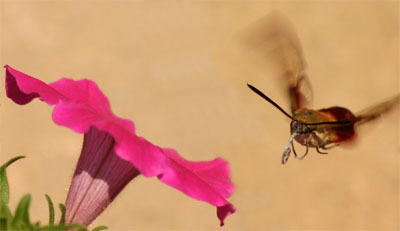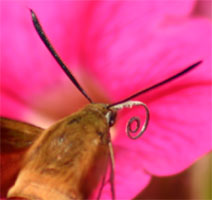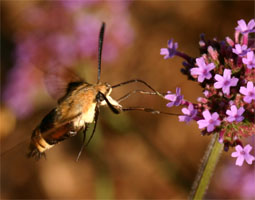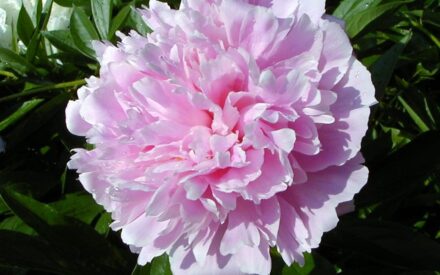
Have you noticed something visiting your flowers but you aren’t quite sure whether it’s a bee, or a small hummingbird, or a fat butterfly? It’s likely what you saw was a hummingbird clearwing, Hemaris thysbe. It is just one of a number of moths commonly referred to as hummingbird moths. This species in the Family Sphingidae is fairly common throughout the eastern half of the U.S. and Canada. The moths lack scales on the wings except for a dark border around the edge, giving rise to the common name for the group, clearwing moths. The hummingbird clearwing has a “furry” greenish-yellow or tan body with a wide reddish-brown band across the abdomen, and a wingspan of 1½ to 2¼ inches.

Hummingbird moths visit flowers during the day (unlike most moths), hovering over the plants to feed on nectar with a long proboscis. They typically stay at each flower only briefly, before darting off to a new flower. The proboscis coils up like a party noisemaker when not in use.

Hummingbird clearwings will nectar at a variety of flowers, but favorites in a southern Wisconsin garden may be petunia and especially Verbena bonariensis. Other reports indicate butterfly bush (Buddleia), butterfly weed (Asclepias tuberosa), purple coneflower (Echinacea purpurea), bee balm (Monarda), Joe-pye weed (Eupatorium) and many others are attractive to these moths.
These moths have one or two generations per year depending on location and temperatures.

Adults are usually seen in mid-summer in Wisconsin. The caterpillars feed on Viburnum and related plants. Pale green eggs are laid singly on the underside of leaves in early spring, from which hatch green larvae with a well-developed anal horn. (Another common name for the Family Sphingidae is “hornworms”.) Once they have completed their development, they pupate in dark brown, thin walled cocoons under leaf litter.

Another moth in our area that is frequently seen visiting flowers and hovering like a hummingbird is the white-lined sphinx moth,Hyles lineata. That species is larger than the hummingbird moth, its wings are completely covered with scales, and it tends to be more active at dusk than during the day. There are also many other moths in the Family Sphingidae that are commonly called “hummingbird,” “sphinx,” or “hawk” moths and are occasionally seen feeding at flowers.
One species very similar to Hemaris thysbe is the graceful clearwing, H. gracilis. This moth is very similar in overall appearance, but it is slightly smaller and is not very common, occurring mainly in the Jack pine/oak barrens and open trails through dry forests in the northern counties of the state. The snowberry clearwing (H. diffinis) is a closely related species, but it looks more like a bumblebee with its yellow to greenish-yellow and black markings.
– Susan Mahr, University of Wisconsin – Madison
Ask Your Gardening Question
If you’re unable to find the information you need, please submit your gardening question here:





 Alternatives to Lawn: Groundcovers
Alternatives to Lawn: Groundcovers Marigolds
Marigolds Peony
Peony Iris Severe Mosaic
Iris Severe Mosaic


